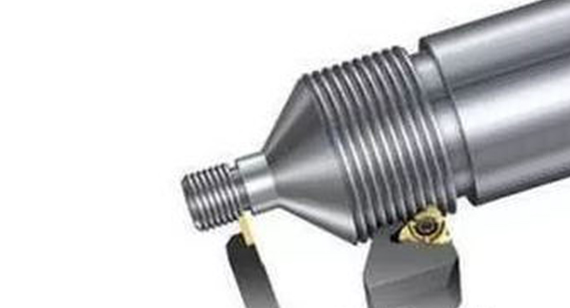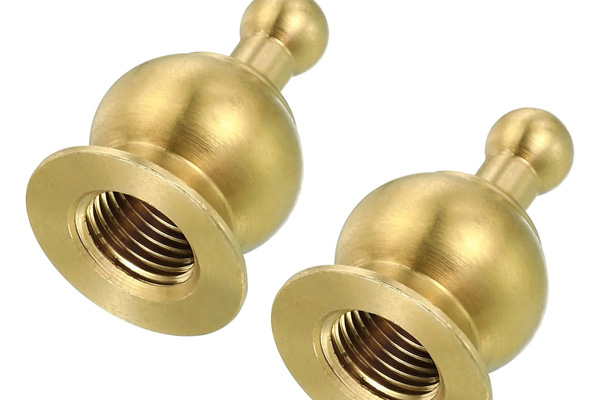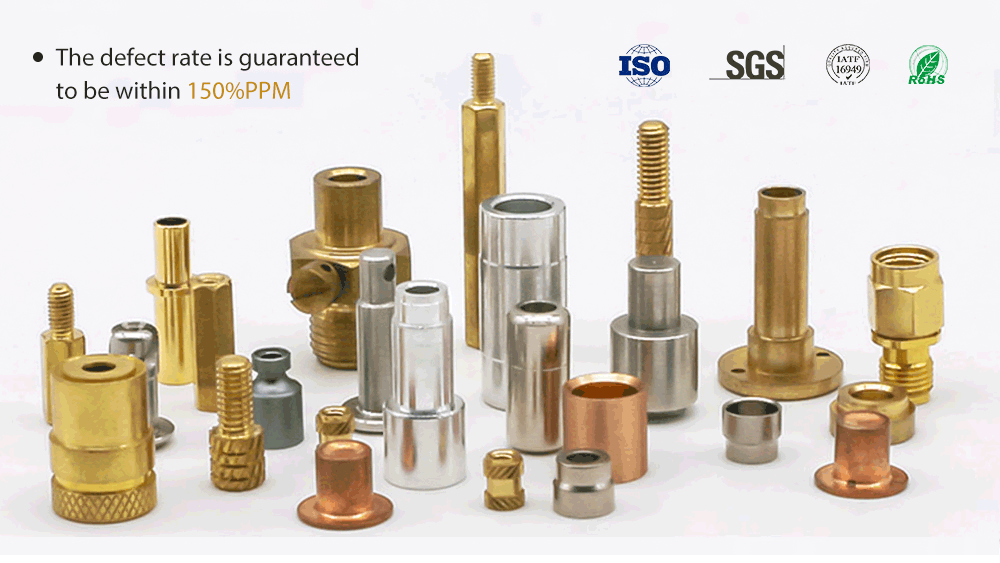15 years one-stop China custom CNC machining parts factory
 2133 |
Published by VMT at Jul 23 2024
2133 |
Published by VMT at Jul 23 2024
In the field of CNC machining parts manufacturing, threads play a crucial role as important elements for connection and fastening. Their design and machining are vital. This article aims to delve into the definitions, differences, main parameters, machining tools, types, and applications of external and internal threads. Through detailed analysis, it will help readers fully understand these two thread forms and enhance their professional skills in CNC machining.

Machined threads refer to spiral grooves formed on the surface of cylindrical or conical parts through mechanical methods (such as turning, milling, tapping, etc.). These grooves are uniformly distributed along the axial direction, forming continuous ridges and grooves used to achieve fastening, connection, or sealing between parts.
An external thread refers to a thread that is directly machined on the external surface of a cylinder or cone. It is typically part of fasteners such as bolts and screws, achieving fastening connection by screwing into an internal thread (such as a nut). The shape and size of external threads must be designed strictly according to relevant standards to ensure tight fitting and interchangeability with internal threads.

An internal thread is a thread machined on the internal surface of a cylinder or cone. It is used to receive an external thread, such as those found in nuts, pipe fittings, and other fastener parts. Internal threads are not visible externally, and their dimensions and shapes must also adhere to strict standards to ensure a proper fit with external threads.

The main differences between external and internal threads lie in their location and form. External threads are located on the external surface of a cylinder or cone, with the thread profile directly exposed, as seen in bolts. Internal threads are located on the internal surface of the body (such as nuts, pipe fittings, etc.), with the thread profile at the bottom of the groove, usually not directly visible. Additionally, they differ in machining methods, application scenarios, and fitting methods.
1. Thread Series:
Thread series refer to thread types classified according to specific standards, such as Metric threads (M), Unified threads (UNC, UNF, UN, UNEF), and Pipe threads (NPT/NPS/NPTF). Each series has specific size and tolerance requirements.
2. Thread Type:
Threads can be categorized by the shape of their profile, including triangular, trapezoidal, and rectangular threads. Each type is suitable for different working conditions and connection requirements.
3. Nominal Diameter/Major Diameter/Thread Size:
The nominal diameter is the basic size of the thread and the basis for calculating other parameters. The major diameter is the largest diameter of the external thread or the bottom diameter of the internal thread. Thread size also includes minor diameter (top diameter of the internal thread), pitch diameter (middle diameter of the thread profile), etc.
4. Pitch:
Pitch refers to the distance between two adjacent thread peaks or valleys on the same circumference. It determines the tightness and engagement length of the thread. The larger the pitch, the sparser the thread; the smaller the pitch, the denser the thread.
5. Depth:
Depth refers to the height of the thread profile, i.e., the distance from the thread peak to the valley. It affects the strength and sealing performance of the thread.
6. Tolerance:
Tolerance refers to the allowable deviation range of the thread size. It ensures the interchangeability and reliability of the thread connection.
7. Fit Class/Tolerance/Allowance:
Fit class indicates the tightness of the fit between internal and external threads. Different fit classes correspond to different tolerance and allowance requirements to meet different application needs.
There are many types of tools used to machine threads, mainly including cutting tools and rolling tools. Cutting tools such as taps, dies, thread turning tools, and thread milling cutters form threads by cutting away material. Rolling tools such as thread rolling dies and rolling wheels form threads by plastic deformation, causing material to flow plastically. These tools are widely used in CNC machining, and suitable tools can be selected based on specific needs and machining conditions.
1. Metric Threads (M)
Metric threads are one of the most commonly used thread types, with an isosceles triangular profile, widely used in machinery, construction, and other fields. The nominal diameter and pitch of metric threads are expressed in millimeters.
2. Unified Threads (UNC, UNF, UN, UNEF)
Unified threads are a thread standard developed by the American National Standards Institute (ANSI), including coarse threads (UNC), fine threads (UNF), constant pitch threads (UN), and extra fine threads (UNEF). They are widely used in the automotive, aerospace, and other industries.
3. Pipe Threads (National Pipe Thread) (NPT/NPS/NPTF)
Pipe threads are mainly used for pipe connections, including taper pipe threads (NPT) and straight pipe threads (NPS). NPT threads have good sealing properties, widely used in the petroleum, chemical, and other industries.
4. Multi-Start Threads
Multi-start threads are threads with multiple helical lines machined on a cylinder. These threads offer higher transmission efficiency and load-bearing capacity but are more challenging to machine.
5. British Standard Pipe Threads (BSPT)
British Standard Pipe Threads (BSPT) are a tapered pipe thread standard with a trapezoidal profile, mainly used in the UK and its former colonies for pipe connections.
6. Thorlabs
Thorlabs threads are a special thread type mainly used in optical and precision instrument fields. Their unique thread profile design meets high precision and high stability connection requirements.
7. ACME
ACME threads are a type of trapezoidal thread with a larger profile angle, usually around 29 degrees. ACME threads are used in applications requiring high torque transmission or high load-bearing capacity, such as machine tools, transmission devices, and lifting equipment. Due to their clear profile and easy machinability, ACME threads are also commonly used in precision machinery.

External Thread Applications:
External threads are used in scenarios requiring fastening connections. For example, the external threads on bolts and screws fit with internal threads in nuts to achieve fastening connections. External threaded pipe fittings connect with internal threaded pipe components to seal and fix pipes. Additionally, external threads are widely used in transmission devices like gears and pulleys to transmit and convert power through thread engagement with other parts.
Internal Thread Applications:
Internal threads are used in scenarios requiring receiving external threads. Nuts are the most typical internal thread parts, fitting with the external threads of bolts or screws to achieve fastening connections. Internal threads on various pipe fittings, valves, and pump bodies connect with external threaded pipes and components. Internal threads are also used in sealing applications, such as cylinder heads and oil pans, by installing seals (like gaskets and O-rings) to achieve sealing effects.
In summary, external and internal threads are crucial elements in the CNC machining parts manufacturing field, and their design and machining significantly affect the performance and service life of parts. By deeply understanding the definitions, differences, main parameters, machining tools, types, and application scenarios of external and internal threads, we can better master thread machining techniques, improve machining accuracy and efficiency, and meet the demands for threaded parts in various fields. As technology continues to advance, new thread types and machining techniques emerge, bringing more possibilities and challenges to the CNC machining field.
1. What are External Threads Used For?
External threads are mainly used for fastening connections. For example, external threads on bolts and screws fit with nuts to achieve fastening connections. External threaded pipe fittings connect with internal threaded pipes to seal and fix pipes. In transmission devices, external threads are used to transmit power and torque.
2. What are Internal Threads Used For?
Internal threads are used to receive external threads. Nuts are typical internal thread parts, fitting with bolts or screws to achieve fastening connections. Internal threads on pipe fittings, valves, and pump bodies connect with external threaded pipes and components. Internal threads are also used in sealing applications, like cylinder heads and oil pans, by installing seals to achieve sealing effects.
3. Can You Roll Internal Threads?
Yes, internal threads can be machined by rolling. Thread rolling is an efficient, precise method that forms the desired thread shape through plastic deformation using rolling tools. Thread rolling produces high-precision, high-quality threads with high strength, widely used in precision machinery and aerospace.
4. How to Identify Internal and External Threads?
Internal and external threads can be identified by their location and shape. External threads are machined on the outer surface of a cylinder or cone, with the thread profile exposed. Internal threads are on the inner surface of the body (such as nuts or pipe fittings), with the thread profile at the bottom of the groove, usually not visible. Measuring tools (like thread gauges) can also be used to measure thread dimensions and parameters for further confirmation.
5. Do Bolts and Screws Have Internal Threads?
Bolts and screws themselves do not have internal threads. Bolts have external threads on the head and shank for fitting with internal threads in nuts or other parts. Screws, with external threads, can directly screw into internal threaded holes, achieving fastening connections without additional nuts. Therefore, bolts and screws have external threads.
This concludes the detailed explanation of the differences between external and internal threads, helping readers better understand and master the related knowledge.
